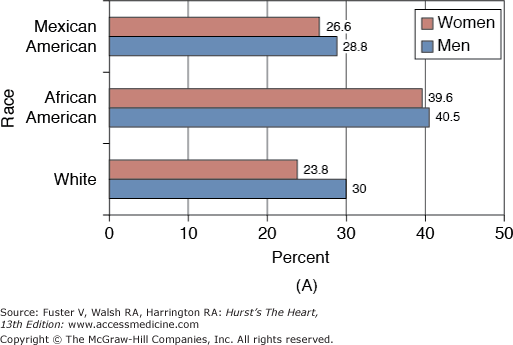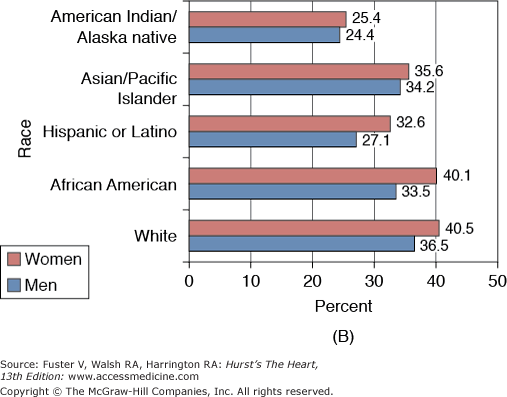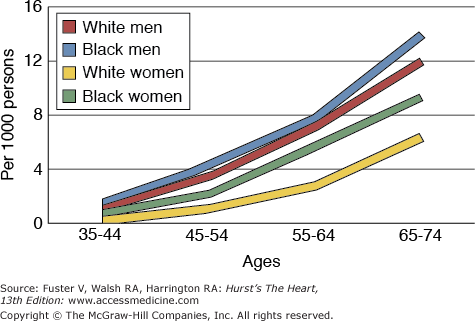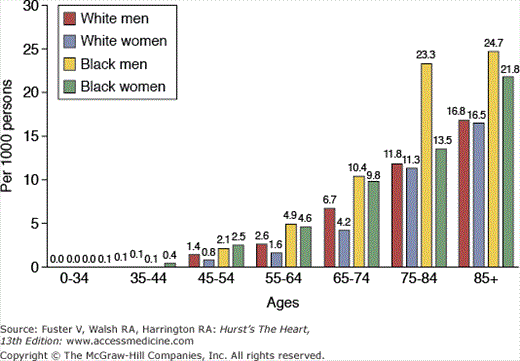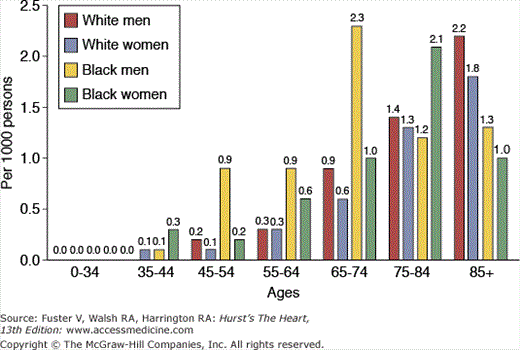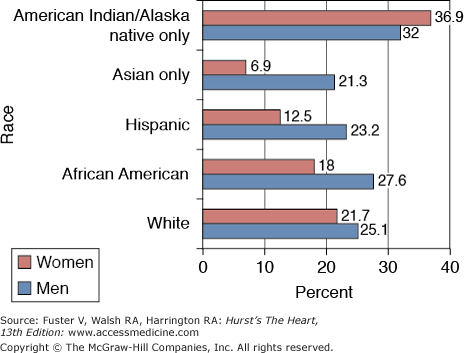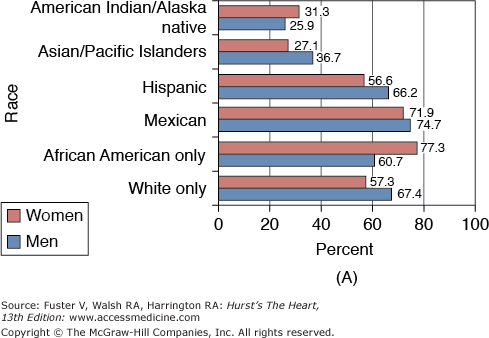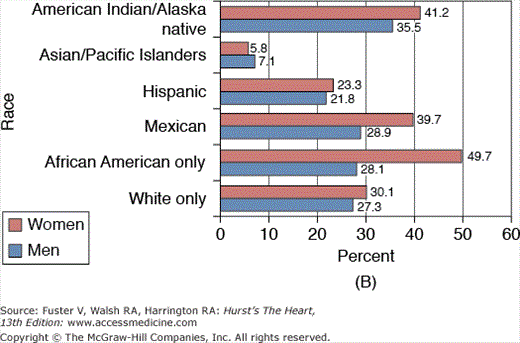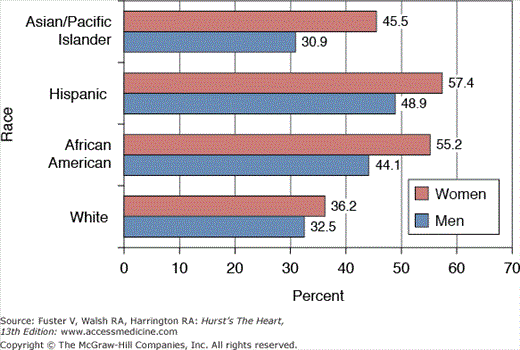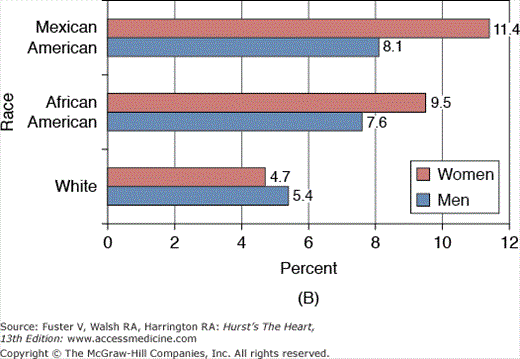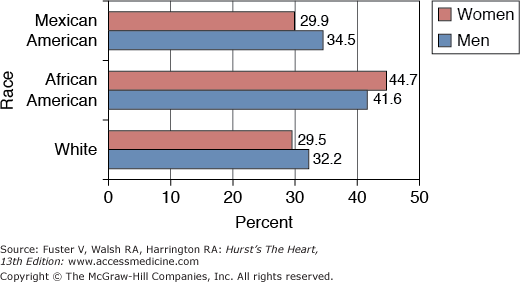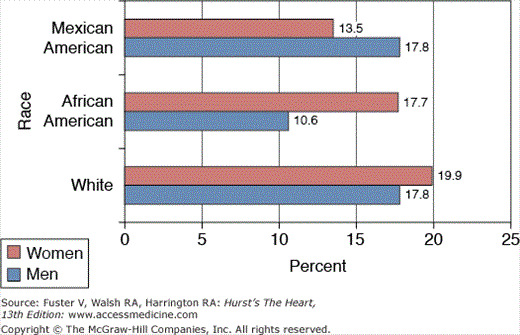Race/Ethnicity and Cardiovascular Disease: Introduction
Although race, ethnicity, and geographic ancestry have been associated with differences in disease prevalence, expression, and outcomes, the public and academic discourse surrounding the role of race/ethnicity in health and disease has been intense and complex. In the United States and many parts of the world, racial/ethnic differences have been used for social and political purposes to confer advantage to some and disadvantage to others based on presumed natural superiority or inferiority. As a result, a philosophic and policy goal of the late 20th century has been to eliminate use of inherent racial/ethnic differences for purposes of societal stratification and advantage. However, recent advances in genetics and pharmacogenetics have resulted in renewed discussion of biologic and genetic correlates of race and geographic ancestry, raising new questions about the nature and meaning of race in health care.1-8 Factors adding complexity to the analysis of the health impact of race/ethnicity are the high prevalence of racial misclassification and the admixture of populations typical of the United States. However, despite the recent genetic data, it remains true that African Americans and other non-European minorities have had societally imposed disadvantages in economics, education, and access to healthy environments, as well as faced barriers to adequate health care, all of which increase disease prevalence, morbidity, and mortality. Thus, discussions about cardiovascular health by racial and ethnic groups require the context that environmental factors in their broadest sense and some genetic factors are operative in determining health risk among different racial/ethnic groups. In this chapter, we accept that race/ethnicity/geographic descent includes clustering of some common genetic and epigenetic factors and also social, environmental, and lifestyle variables, which have a huge impact on cardiovascular health. A critical challenge for multidisciplinary researchers will be to define the relative contributions of each of these variables to cardiovascular health and disease and to discover how to use knowledge from biologic and social sciences to bring equity in cardiovascular health outcomes across racial/ethnic populations.
Coronary Heart Disease Mortality by Race/Ethnicity
Cardiovascular disease (CVD) has been recognized as the dominant cause of death in the United States for at least 50 years, with heart disease ranking first and stroke third.9,10 Figure 104–1 shows the prevalence of CVD and the percentage of deaths attributable to CVD by major US ethnic groups. Although coronary heart disease (CHD) death rates in all major demographic groups have declined in the United States, the decline in CHD has not been uniform across racial/ethnic groups. For example, in African American men, it declined by 33.3% between 1979 and 1998 compared with 46.1% in white men. At the same time, CHD death rates decreased by 26.6% in African American women compared with 40.1% in white women. Analysis of annual rates of first heart attack, first cerebral infarction, and first cerebral hemorrhage by age, sex, and African American or white race demonstrates higher rates of all three entities in African Americans compared with whites10 (Figs. 104–2, 104–3, 104–4).
Figure 104–1.
A. Prevalence of cardiovascular disease. Total population: 64,400,000 (22.6%); total males: 31,100,000 (21.5%); total females: 33,300,000 (22.4%). From National Health and Nutrition Examination Survey (NHANES) III (1988-1994), Centers for Disease Control and Prevention (CDC)/National Center for Health Statistics (NCHS). Data for white and African American males and females are for non-Hispanics. Total population data include children; percentages for racial/ethnic groups are age adjusted for Americans age 20 years and older. B. Percentage of total deaths attributed to cardiovascular disease (from CDC/NCHS).
Cardiovascular Risk Factors by Race/Ethnicity
A differential prevalence of risk factors for CVD exists by race/ethnicity and may contribute to a portion of the differences in outcomes by race/ethnicity,11 either by virtue of the number of and duration of exposure to risk factors clustered by race/ethnicity and/or to differences in the intensity of treatment of risk factors by race/ethnicity.
Approximately 25% of the overall US adult population continues to smoke on a daily basis. Smoking prevalence rates vary markedly by racial/ethnic group and sex. Native Americans have the highest prevalence rates, and African American men without a high school diploma have the next highest smoking rate. The lowest rates of smoking are found in Hispanic and Asian women (Fig. 104–5).
Current estimates of body mass index (BMI) from the National Health and Nutrition Examination Survey (NHANES) III for US adults age 20 to 74 years indicate that approximately 60% of men and 50% of women are overweight, with 20% of men and 25% of women being obese,12 with significant variation by ethnicity (Fig. 104–6).
Figure 104–6.
A. Prevalence of overweight and obesity in adults in 2001. Total population: 130,760,000 (64.5%); total males: 65,250,000 (67.2%); total females: 65,510,000 (61.9%). B. Prevalence of obesity in adults in 2001. Total population: 130,760,000 (64.5%); total males: 65,250,000 (67.2%); total females: 65,510,000 (61.9%).
With respect to physical activity, data from 1996 suggest that only 28% of adults meet the recommended levels of moderate or vigorous physical activity, and 29% report no physical activity outside of work. The prevalence of physical inactivity increases with age, is higher in women than men, and is highest in African Americans and Hispanics (Fig. 104–7).10,13,14
Figure 104–7.
Prevalence of physical inactivity in 1998. Note: Prevalence is the percentage of population who report no leisure-time physical activity. Data are age adjusted for Americans age 18 years and older. From National Health Interview Survey (1997-1998), Centers for Disease Control and Prevention/National Center for Health Statistics.
Diabetes mellitus, a major contributor to CVD morbidity and mortality in the United States has increased in incidence by 49% in the past decade, closely coupled to the rapidly increasing incidence of obesity. Among people age 20 years or older, the prevalence of diabetes in the United States is highest in American Indians and Alaska Natives, followed by African Americans. On average, African Americans are 1.6 times more likely to have diabetes than non-Hispanic whites of similar age. Hispanic/Latino Americans are 1.5 times more likely to have diabetes than non-Hispanic whites. Mexican Americans, the largest Hispanic/Latino subgroup, are more than twice as likely to have diabetes as non-Hispanic whites of similar age (Fig. 104–8).10,15-16
Figure 104–8.
A. Age-adjusted total prevalence of diabetes in people age 20 years or older by race/ethnicity in the United States in 2002. Data from 1999 to 2001 National Health Interview Survey, 1999 to 2000 National Health and Nutrition Examination Survey estimates projected to year 2002 and 2002 outpatient database of the Indian Health Service. B. Prevalence of physician-diagnosed diabetes mellitus in 2001. Total population: 11,100,000 (5.5%); total males: 5,100,000 (5.5%); total females: 6,000,000 (5.5%). Total Hispanics: 5.5%; total Asian/Pacific Islanders: 4.6%; total American Indians/Alaska Natives: 7.6%. Total percentages for racial/ethnic groups represent the portion of total mortality that is males versus females. Percentages for racial/ethnic groups are age-adjusted for Americans age 20 years and older. From National Health and Nutrition Examination Survey III (1988-1994), Centers for Disease Control and Prevention/National Center for Health Statistics.
Hypertension is the most prevalent risk factor for CHD, heart failure, stroke, and renal disease and affects more than 43 million Americans, with an estimated age-adjusted prevalence of 26% of all adult males and 22% of all adult females.10 African Americans have the highest prevalence (Fig. 104–9), earliest age at onset, and most severe target organ damage at all ages and in both sexes. Of importance, although awareness and treatment of hypertension are higher in non-Hispanic blacks, achievement of target treatment blood pressure is lower in this group.
Figure 104–9.
Prevalence of high blood pressure in 2001. Total population: 50,000,000 (32.8%); total males: 33.1%; total females: 32.1%. Total Hispanics: 18.6%; total Asian/Pacific Islanders: 16.3%; total American Indians/Alaska Natives: 20.7%. From Hajjar I, Kotchen TA. Trends in prevalence, awareness, treatment, and control of hypertension in the United States, 1988-2000. JAMA. 2003;290:199-206.
According to the Behavioral Risk Factor Surveillance System, the prevalence of hypercholesterolemia was generally high among white and Mexican American men and white women in all education groups, with lesser prevalence in African Americans.15 However, African Americans and Hispanics with dyslipidemia are less likely to be treated to guideline-recommended goals (Fig. 104–10).17
Figure 104–10.
Prevalence of total cholesterol of ≥240 mg/dL in 2001. Total population: 37,000,000 (18.3%); total males: 16,500,000 (17.2%); total females: 20,500,000 (19.1%). Total Hispanics: 25.6%; total Asian/Pacific Islanders: 27.3%; total American Indians/Alaska Natives, Oklahoma: 28.6%; total American Indians/Alaska Natives, Washington: 26.5%. Percentages for race/ethnicity from Behavioral Risk Factor Surveillance System (1997), Morbidity and Mortality Weekly Report, Vol. 49, No. SS-2, March 24, 2000, Centers for Disease Control and Prevention/National Center for Health Statistics. Data are for Americans age 18 years and older.
Aspects of CVD by High-Risk Population Groups
Recently, data indicated that CVD is the leading cause of death among American Indians with variation in mortality by tribal affiliation. The Northern Plains Indians have higher rates of CHD, and the Southwestern Indians have lower rates of CHD.18 Data from the Strong Heart Study19 suggested that CVD incidence rates among Native Americans are increasing and that CVD may more often be fatal in American Indians. A total of 4549 participants, age 47 to 74 years old, were subjected to surveillance (average, 4.2 years). CVD morbidity and mortality were higher in men than in women. The CHD incidence rates among American Indian men and women were almost two-fold higher than those of subjects of European descent in the Atherosclerosis Risk in Communities Study.19 A significant contributor to the high rate of CVD in American Indians is the high prevalence of smoking and diabetes in these communities. Seventy percent of American Indians in Arizona and >40% in Oklahoma and South and North Dakota have diabetes. In a study of 75,993 death certificates in Montana from 1991 to 1995 and 1996 to 2000, an analysis was performed of heart disease and stroke death rates (per 100,000) for American Indians and whites.20 There were striking differences in premature death from heart disease among American Indians compared with whites. Forty percent of American Indian men and 29% of American Indian women who died of heart disease during these years were <65 years old compared with only 21% of white men and 8% of white women. The percentage of the American Indian adult population with two or more risk factors for heart disease increased from 34% in 1999 to 44% in 2003. These data show a significant increase in CVD risk and mortality among middle-aged American Indians and a growing disparity in CVD mortality compared with the general population.21
Hispanic or Latino is considered a designation of ethnicity, not race, and people of Hispanic or Latino origin may be of Cuban, Mexican, Puerto Rican, South or Central American, or other Spanish culture or origin, regardless of race.22 The US Hispanic population has become the fastest growing and largest minority group in the United States. In the year 2000, there were an estimated 35.3 million Hispanics (12.5% of the total US population), with Mexican Americans being the largest ethnically distinct subgroup of Hispanics.
On average, Hispanics have more risk factors for CHD than non-Hispanic whites, including higher BMIs, more central obesity, lower high-density lipoprotein (HDL) cholesterol, and higher triglyceride levels.23 Cigarette smoking and diabetes are more prevalent in Hispanics, whereas the prevalence of hypertension is similar to that in whites. In addition, Hispanics have lower socioeconomic levels and less health insurance coverage and use fewer preventative services compared with non-Hispanic whites.23 Previous observational population-based studies suggested that despite the fact that Hispanics have higher rates of diabetes and obesity as well as barriers to health care, they have lower all-cause and cardiovascular mortality rates than do non-Hispanic whites.24,25 This phenomenon has been dubbed the Hispanic paradox.
In the Can Rapid Risk Stratification of Unstable Angina Patients Suppress Adverse Outcomes With Early Implementation of the ACC/AHA Guidelines (CRUSADE) study,26 data were evaluated regarding the management of non–ST-segment elevation acute coronary syndrome in Hispanic patients. Hispanics were younger and had less hyperlipidemia but were more likely to be hypertensive and diabetic. During hospitalization, Hispanics were more often managed conservatively, undergoing stress testing more frequently and interventional procedures (cardiac catheterization [48.7% vs 55.5%; P < .001] or angioplasty [39.6% vs 46.4%; P < .001]) less frequently than non-Hispanic whites. Adjusted in-hospital mortality was the same for the two groups. Data from the second National Registry of Myocardial Infarction showed no significant differences in in-hospital mortality between Hispanics and non-Hispanic whites.27 However, data from the San Antonio Heart Study has provided cause to question the validity of the Hispanic paradox.28,29 After 15 years of follow-up, it was observed that Mexican Americans, compared with non-Hispanic whites, had more than a 50% greater risk of all-cause mortality, a 70% greater risk of cardiovascular mortality, and a 60% greater risk of CHD mortality. Similarly, data from the Corpus Christi Heart Project,30,31 a community-based surveillance program, have shown both greater rates of hospitalization for CHD and worse in-hospital survival after myocardial infarction among Mexican Americans compared with non-Hispanic whites. Thus, although in some studies Hispanics with acute coronary syndrome appear to have equivalent short-term outcomes compared with whites, long-term follow-up studies suggest that outcomes are poorer.
Multiple studies of immigrants of South Asian ethnicity (Indian and Pakistani) have found a three- to five-fold increase in the risk for myocardial infarction and cardiovascular death compared with other ethnic groups. In an analysis of age-standardized CHD mortality in Canada over a 15-year period, South Asians had the highest CHD mortality compared with individuals of Chinese or European descent.32 In addition, South Asians tend to develop CHD at younger ages (often before age 40) and are more likely to have significant left main, multivessel, and distal coronary artery disease.33
The INTERHEART study34 demonstrated that the burden of CHD in the Indian subcontinent is largely explained by traditional risk factors common to all populations at risk for CVD but with different prevalence compared with other populations.
The use of tobacco is lower among South Asian men and almost nonexistent among South Asian women. The levels of low-density lipoprotein (LDL) cholesterol are comparable to other populations, but the LDL cholesterol particles tend to be the smaller, more atherogenic particles in South Asians. South Asians also have the lowest HDL cholesterol levels. The prevalence of diabetes is higher in South Asians than other populations. Compared with European populations, South Asians have increased abdominal visceral fat and greater insulin resistance at similar levels of BMI including BMI levels that are considered ideal (<25 kg/m2).35,36
In the Study of Health Assessment and Risk in Ethnic Groups (SHARE) trial,35 South Asians were found to have a higher prevalence of subclinical atherosclerosis, and South Asian ethnicity was an independent predictor of CVD. It has been suggested that more aggressive screening be done in this population.36
Stay updated, free articles. Join our Telegram channel

Full access? Get Clinical Tree


